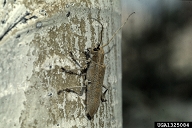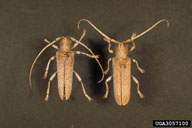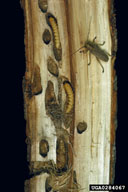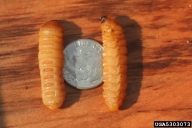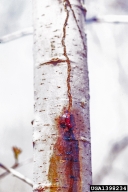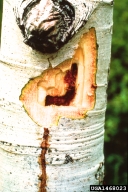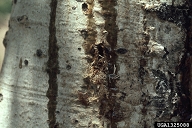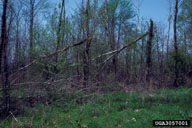Poplar borer
Saperda calcarata Say (Coleoptera: Cerambycidae)
Orientation to pest
Poplar borer, Saperda calcarata Say, is a native North American insect found throughout Canada and the United States, attacking poplars (Populus) and on occasionally willows (Salix). It can become a significant pest of both eastern cottonwood (Populus deltoides Bartr. Ex Marsh) in southern regions and quaking aspen (Populus tremuloides Michx.) further north. Overwintered adults emerge from June until August. Females lay eggs in slits chewed into the bark, most often in isolated, trees growing in full sun or in trees along stand edges where they are more exposed to sunlight. Trees stressed by over-maturity, grass competition, or poor site conditions are more likely to be attacked. Larval development typically takes 3-4 years, but can vary from two to five. Signs and symptoms of this pest include swollen areas on trunks and larger branches, exit holes, and woodpecker excavations. Infested trees may have varnish-like stains on the bark below the points of attack, where reddish sap has oozed out. Fresh sap and coarse, fibrous frass are good indicators of an active larval gallery. Infestations often do not kill trees outright, but the trunk or branches may be weakened and break in wind, ice, or snow storms. Small trees may be killed by girdling from joining of several larval galleries. Surveys in northern states and Canadian provinces have found attack rates on quaking aspen by poplar borer to be quite high (>50%), especially in more open park-like settings where trees are open-grown. Maintaining well-stocked stands and avoiding poor-quality sites reduces the likelihood of infestation. Removal of infested trees was not shown to be helpful in reducing infestation levels since it resulted in lower stand density that encouraged further attack. It is recommended that poplar stands be well-stocked and clear cut at maturity.
Hosts commonly attacked
Poplars (Populus) are the preferred hosts of this borer. Quaking aspen (P. tremuloides) is favored in northern areas, cottonwood in southern areas. Balsam poplar (Populus balsamifera L.) is another favored host where it occurs. Willow (Salix) has been reported as a host.
Distribution
This species is found throughout Canada and the United States where poplars are present.
Images of poplar borer
| Figure 1. Adults of poplar borer, Saperda calcarata | Figure 2. Larvae of poplar borer in galleries and pupa in pupal chamber, surrounded by characteristic coarse fibrous frass (left); close up of poplar borer larvae (right) | ||
| Figure 3. Sap leakage and bark staining on quaking aspen is a sign of poplar borer infestation | Figure 4. Internal appearance of poplar borer damage, with bark cut open | Figure 5. Frass being expelled from larval gallery of poplar borer | Figure 6. Eastern cottonwood trees (Populus deltoides ssp. deltoides Bartram ex Marsh.) broken due to tunneling of poplar borer |
Important biological control agents related to this pest species
Natural mortality of the poplar borer is frequently high and a variety of parasitoids have been reared from this species in various locations. Studies in Canada revealed that egg infertility, climate, excessive sap flow, and natural enemies destroyed 81% of the population of this borer. Woodpeckers can remove many late-stage larvae. However, while descriptive work has been done in some locations, no fundamental understanding exists of the importance of natural enemies as control agents for this borer.
Web links for information on poplar borer
- Fact Sheet | CSU/Denver County Extension, Master Gardener 2010
- BugwoodWiki Article | wiki.bugwood.org
Articles
- Solomon, J. D. 1995. Guide to insect borers of North American broadleaf trees and shrubs. Agricultural Handbook 706. Washington D.C.: U.S. Department of Agriculture, Forest Service, 735 pp. (Saperda calcarata, pages 334-338).
- Broberg, C. L. and J. H. Borden. 2005. Host preference by Saperda calcarata Say (Coleoptera: Cerambycidae). Journal of the Entomological Society of British Columbia 102: 27-34.
